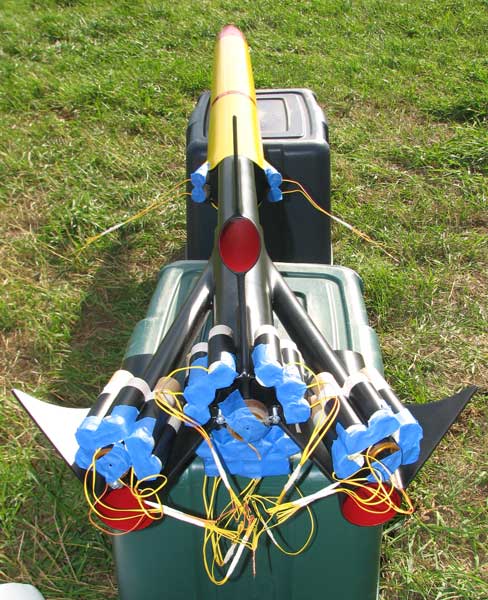I have made several launches of my 3-motor Micromaxx cluster saucer (a modified version of Art Applewhite's free MMX original saucer plan) using a standard clip whip and QMX igniters that were stripped of their plastic housings and supported in the nozzles by toothpicks. The motors are bunched together, Estes Ranger-style, instead of being spread apart like they are in the Diminutive Deuce. So, as you can imagine, space is tight. Also, the toothpick supports are very much on the rickety side. Finally, the leads on the QMX igniters are quite short. These igniters, like the current Micromaxx ones, have no pyrogen, just a bare length of nichrome bridge wire between the leads. It is really tricky to get everything hooked up without touching or falling off, especially when you are using a Quest Silo launch pad that is sitting on the ground. Still, it can be done. I have a perfect record with that saucer. I use my AT Interlock controller with a 12 volt power source to fire them.
To be perfectly honest: 2 & 3 motor clusters should work fine with just about any attachment method as long as your using a 12V battery and short lead lines.....most of the time. A bad igniter, sloppy igniter installation or hap-hazard twisting can cause less then the desired results. and for the casual 2,3, & sometimes 4 motor cluster flyer that'll work out fine.
But please understand a clipwhip is nothing more then an extension of the existing system to which it is connected. It is also adding another potential problem area in the connection/attachment points. If well made, with good materials a clipwhip should work just fine on small 2, 3 and
most 4 motor clusters.
It's in the higher number of motor clusters, that Relay systems with direct leads, larger gauge wire connection and so on become so important. Preperation time and attention to detail are the most critical part to 3 & 4 motor clustering success that is: ensuring all igniters are good and in contact with the propellant, Contact clips and connections are clean and Tight, and the battery can supply the necessary 2amps pre igniter.
I started using Relays on all clusteres more the 30 years ago when I only got 3 of 4 motor to light on my brand new 1/70th Scale Saturn 1B. I wanted to be able to give myself and my clustered models the very best chance of success on every flight. That Saturn-1B and most of my other clusters are still flying. My cluster motor success rate is not perfect.. some intentional most not, I've Logged 13 unlit motors in all those
thousands of clustered flights over the years.. but that's still a very high success rate. The more one practices a particular thing, studies the process involved and works out a procedure that works for their particular flying style, that individual will have the most fun with the ART of Clustering.
Some years back I wrote an Article "Clustering BP motors" that's published as a Tech-Tip in the Library at
www.narhams.org Tip-006 has been updated periodically and is available for anyone to download or just read at their leasure if they are interested clustering BP motors. While it's not the only answer it's certainly been extremely successful for many who have used it's contents.










